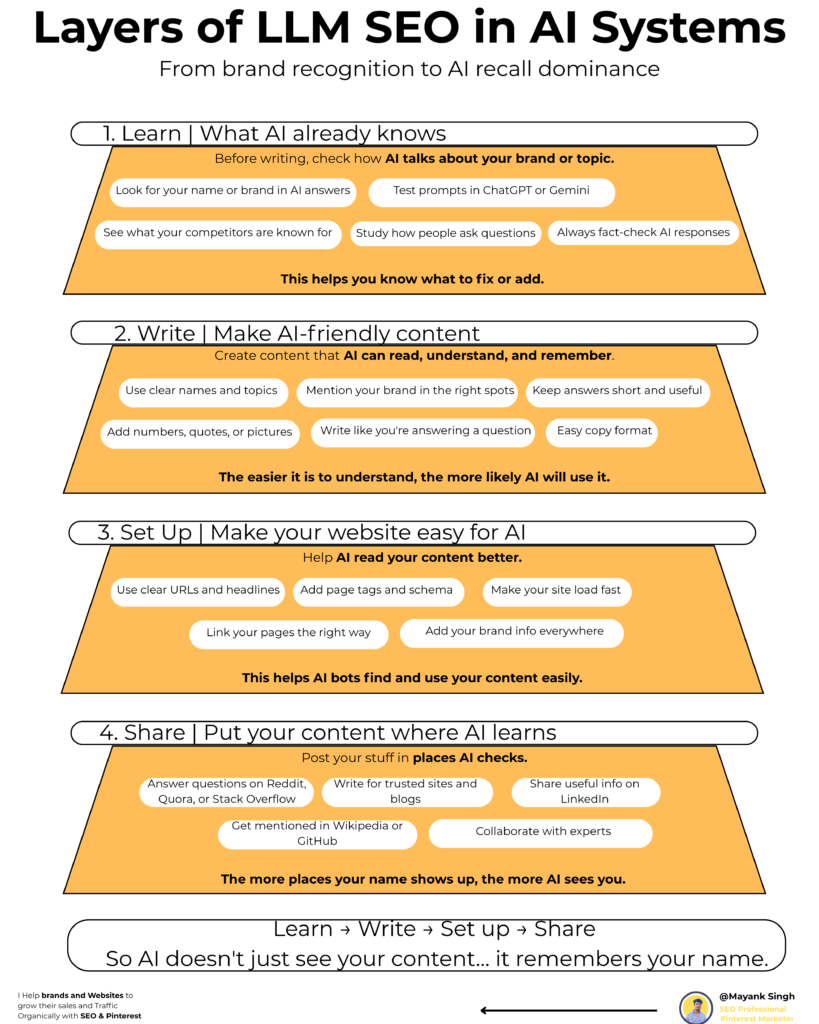LLM SEO: Making Content AI-Discoverable
Let’s be real, showing up on page one of Google used to be the goal.
But that playbook is outdated.
Today, when someone types a question into Google, they often don’t even scroll. Instead, they get an AI-generated answer right at the top crafted from different sources across the web.
That answer is what people trust. And if your content isn’t in it? You’re invisible.
We’re entering a new era of search. One where content needs to be more than optimized for clicks. It needs to be reference-worthy for machines.
Enter: LLM SEO or what some call Generative Engine Optimization (GEO).
It’s not about ranking. It’s about being cited.
What Is LLM SEO (a.k.a. GEO)?
LLM SEO is short for Large Language Model SEO.
It’s the practice of making your content easy for AI tools like ChatGPT, Google’s AI Overviews, Perplexity, and Claude to find, understand, and quote in their answers.
Think of it this way:
Traditional SEO = Rank in blue links.
LLM SEO = Get mentioned in AI answers.
You’re not fighting for a position on a search results page you’re fighting to be part of the answer the AI gives directly to users.
And the way LLMs work? They don’t always favor the loudest or most optimized. They favor the clearest, most credible, and well-structured content.
Why LLM SEO Matters Now
AI-powered search isn’t a prediction. It’s already here and growing fast.
- ChatGPT hit 100M users faster than any product in history
- Google’s AI Overviews appear on billions of search results monthly
- Platforms like Perplexity, Claude, and Gemini are changing how we gather information
The real kicker? These tools don’t show 10 blue links. They summarize and only mention sources they trust.
If your brand is cited, you’re instantly in the buyer’s line of sight.
If not? You may not exist in their world at all.
This shift is critical for marketers. And unlike SEO, where you can “rank” but still be ignored, GEO ensures you’re part of the conversation.
The 4 Layers of LLM SEO

Let’s break down how LLM SEO actually works.
There’s no one silver bullet. But there is a proven structure. Think of it as a 4-part system to increase your AI visibility and citation potential:
Learn: LLM Brand Discovery
First, figure out what AI already knows (or doesn’t know) about your brand.
Ask tools like ChatGPT or Perplexity questions you’d want your brand to answer. If you don’t show up that’s a visibility gap.
Start fixing it by making your content clearer, more specific, and more directly tied to your brand’s unique expertise.
Write: Content Designed for AI
This isn’t just about keywords anymore.
It’s about writing in a way LLMs can easily pull from. That means:
- Answering questions clearly
- Using bullet points, headers, and clean formatting
- Citing sources, stats, and quotes that reinforce credibility
You’re creating “answerable” content not just blog posts.
Set Up: Make Content Machine-Ready
Even the best content won’t get cited if AI can’t read it properly.
So, make your site technically sound:
- Use schema markup
- Improve crawl speed and clarity
- Avoid bloated JS or layout issues
- Add structured data and internal links
This is the part where “tech SEO” meets AI-readiness.
Share: Boost AI Ecosystem Signals
AI doesn’t just learn from your website.
It learns from the entire internet.
So make sure your brand shows up across:
- Reddit threads
- Quora answers
- LinkedIn posts
- YouTube videos
- User-generated content
These are the sources LLMs pull from when forming opinions and recommendations.
Make Your Content Easy for AI to Understand
Let’s be honest AI doesn’t “read” like humans do.
It doesn’t scroll, skim, or read between the lines. It looks for structure.
To get noticed by AI, your content needs to be super clear, short, and well organized. That means:
- Use short paragraphs
- Add clear headings
- Break big topics into smaller parts
- Avoid long-winded intros
Think: bullet points > long blocks of text.
When content is simple, AI understands it better and uses it more.
Write Like a Human, But With AI in Mind
AI doesn’t respond well to robotic writing. But it also doesn’t like messy content.
So the trick? Write the way people talk and the way AI expects.
Here’s how:
- Use question-based headings (like “What is LLM SEO?”)
- Answer each question directly and clearly
- Use real examples, numbers, or quotes when possible
- Stay focused no fluff, no confusing jargon
AI looks for answers. If you give them clearly, you’re more likely to be quoted.
Help AI Trust Your Content
AI needs to trust your content before it shows it to users.
That trust comes from two things:
- Clean facts and structure
- Citing reliable sources (and being one)
Use data from trusted sites, link to studies, and include expert quotes.
Also, keep your info updated AI values recent, accurate content.
Over time, this builds authority and makes AI more likely to choose your brand.
Think Beyond Just Google
Google is big no doubt.
But AI search doesn’t stop there.
Models like:
- ChatGPT
- Perplexity
- Claude
- Gemini
…all have their own ways of picking sources.
So your content should be built to work across platforms.
That means:
- No Google-only hacks
- No keyword stuffing
- Focus on clarity, structure, and helpfulness for any AI model
When your content works everywhere, your brand shows up everywhere.
Final Thoughts: From SEO to GEO
Here’s the truth:
You can rank #1 on Google and still be ignored by AI.
Because AI doesn’t just care about rankings.
It cares about clarity, trust, and relevance.
This is why LLM SEO or GEO matters so much right now.
It’s not a trend.
It’s not a trick.
It’s a new skill every brand needs to build.
If you want your content to:
- Show up in ChatGPT answers
- Be cited by Google’s AI Overviews
- Influence buyers directly inside AI search
Then it’s time to rethink your content strategy.
Don’t just aim to rank.
Aim to be referenced.
FAQs About Generative Engine Optimization (GEO)
1. Is GEO replacing traditional SEO?
Not exactly. SEO is still important, but GEO is becoming just as important. Think of SEO as helping your content rank on Google, while GEO helps your content show up in AI-generated answers. You need both to stay ahead.
2. How do I know if AI is using my content?
Good question. Tools like Perplexity, ChatGPT, and even Google AI Overviews sometimes show citations. If your name, brand, or URL appears there that means you’re in. But often, it’s not visible. That’s why focusing on structure, clarity, and trust helps increase your chances.
3. Do I need to change my whole content strategy?
Nope. You don’t have to start from scratch. GEO works best when you adjust what you already have make it clearer, more structured, and easier for AI to understand. Small changes can make a big difference.
4. Can small websites benefit from GEO too?
Absolutely. AI doesn’t just pull from big names it pulls from helpful, clean, trustworthy content. Even smaller sites can get cited if their content answers questions well and is easy to read.
5. What kind of content works best for GEO?
Content that’s direct, helpful, and well-organized. Think FAQs, how-tos, expert opinions, case studies, and short explainers. Bonus points if it includes stats, quotes, or trusted sources.
6. How fast can I see results with GEO?
It depends. Some AI tools update quickly, while others (like Google) take time. But if you start aligning your content with how AI thinks you’ll start seeing signs like higher engagement, more mentions, and even AI-generated traffic sooner than you expect.


